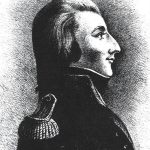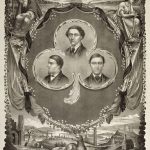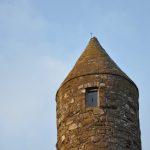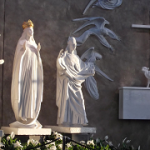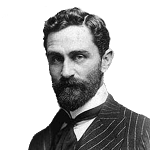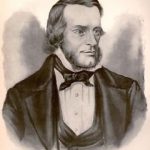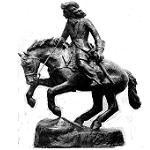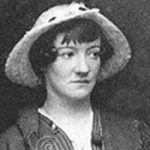Edward Walsh was born in Dublin in 1873 and lived with his family in the North Inner City around the Bolton Street area. Edward married Ellen in 1894 and from that date on, he and his new family lived in the run-down tenements on Henrietta Street and, at the time of the Rising, on Dominick Street. By then they had 2 children, Christopher (20) and Helena (11). He worked as a Carter for McMasters in Capel Street. Edward joined the Hibernian Rifles just after their founding. The Hibernian Rifles were a military wing of the Ancient Order of Hibernians American Alliance. Many of the … [Read more...] about Edward Walsh
THE BIRTH OF REPUBLICANISM
Up to the 20th Century, the closest that the Irish ever came to complete independence happened when Irish Catholics and Protestants united in a brotherhood of purpose for the benefit of all. It started after the American Revolution. The 1777 surrender of General Burgoyne at Saratoga in the American Revolution was followed by the alliance of France to America's cause. The British began to fear an invasion of either England or Ireland. In April 1778, John Paul Jones crossed the Atlantic, captured two British ships, then boldly sailed into Belfast Bay in broad daylight, and sank a British … [Read more...] about THE BIRTH OF REPUBLICANISM
Echoes of History – The Manchester Martyrs
After the American Civil War, the Fenian brotherhood felt the time was right for a long-awaited national rising in Ireland. In February 1867, a small local rising in Cahirciveen, Co. Kerry, finally prompted a national rising which took place on 6 March. Thousands of Fenians took to the hills, but poorly armed, they were easily put down and hundreds were jailed. Unaware of the failure of the rising, support was sent from America’s Fenians. On 23 May, the ship Erin’s Hope with 40 Fenians (former Civil War officers), 5,000 firearms and several artillery pieces on board sailed into Sligo … [Read more...] about Echoes of History – The Manchester Martyrs
IRISH ROUND TOWERS
When one sees Round Towers, it’s only natural to think of Ireland. These impressive monuments from the past have a long, storied and mysterious history; long – because they date back to medieval times; storied – because there are many tales surrounding their purpose; and mysterious – because no one knows the names of those bygone architects who built them. They are mostly found in Ireland, where they were built, sometime between the 7th and 10th century according to the 1911 Encyclopedia Britannica. Their use has provided many theories. Some say they were built as a defense against … [Read more...] about IRISH ROUND TOWERS
Nineteenth Century August
By the mid 1800s, most of the fertile land in Ireland was in the hands of landlords, forcing the Irish to survive on smaller plots, until they became totally dependent on the crop that could produce the most yield per acre – the potato. It was difficult, but at least they weren't starving for potatoes are a remarkable source of vitamins and minerals. Then late on August 20, 1845, a potato fungus was discovered at the Dublin Botanical Gardens. The following day, August 21, is a date remembered in Irish history as the first day of An Gorta Mor - the Great Hunger. Within the week, reports came in … [Read more...] about Nineteenth Century August
IRISH MARTYRS OF MAY
We remember the Patriots of 1916 whose executions began on 3 May and extended until 12 May. However, 75 years later on 5 May, another patriot joined them in Tir na nOg and should also be remembered. It was 1981 and a young 26-year old patriot named Bobby Sands had succumbed to a self-imposed hunger strike. The spin-doctors in the British Information Service were at wits end preparing propaganda, the Irish Diaspora around the world were protesting, and the media had a field day. Sadly, few knew or understood – even while it was happening – the reasons why. Unable to stem the rising tide of … [Read more...] about IRISH MARTYRS OF MAY
SIR ROGER CASEMENT
The last patriot to be executed for his part in the Easter Rising of 1916 was a Protestant from Northern Ireland further disproving the North vs South, Catholic vs protestnat mythology promoted by the British to divide and conquer. His name was Roger Casement and he was born in Antrim on September 1, 1864 to a Protestant father and Catholic mother. At 17, he went to work for the Elder Dempster Shipping Company in Liverpool; three years later he shipped out as purser on one of the company's ships headed for the west coast of Africa. There in 1892 he joined the British Colonial Service and was … [Read more...] about SIR ROGER CASEMENT
The San Patricios
In March we think of St. Patrick and his story is on our national website AOH.COM, so this month we will tell of a remarkable military unit named for our patron saint. When America was a young country, not yet matured with the wisdom born of experience, we made mistakes. The acceptance of slavery, the treatment of Native Americans, prejudice against Catholics, and armed opposition to labor unions, were but a few. But the wisdom of our founding fathers and the form of government they established gave all people a voice, and in time saner heads prevailed in the electoral process and the nation … [Read more...] about The San Patricios
THE FIRST COFFIN SHIPS IN AMERICA
Wallabout Bay is small body of water along the northwest shore of Brooklyn, NY. In 1801, a settlement called Vinegar Hill was built on that bay to attract Irish immigrants to settle there and provide the labor to build the Brooklyn Navy Yard which opened in 1806. However, Vinegar Hill was built on an area which, 20 years earlier, had seen incredible horror! During the American Revolution, the British had captured thousands of soldiers, sailors, and even private citizens who would not swear allegiance to the Crown. When they ran out of jail space to house their prisoners they used ship hulls, … [Read more...] about THE FIRST COFFIN SHIPS IN AMERICA
THE PATRIOT GAME
World War II brought change to Northern Ireland as Loyalists and Nationalists who shared the same bomb shelters broke down the barriers of prejudice erected by the Unionist Ascendancy to keep them divided. The war also created jobs and the small measure of prosperity experienced by the nationalists satisfied many grievances. After the war, England rebuilt the barriers to maintain control of the north. Churchill publicly blasted the Irish Free State for neutrality during the war despite the cooperation extended to the allies by the Irish and the tens of thousands of Irish volunteers in the … [Read more...] about THE PATRIOT GAME
THREE ANCIENT OBSERVATORIES
The Boyne Valley, some 20 miles northwest of Dublin in County Meath, is one of the most remarkable sites on earth, for there stands three monuments to the early settlers of Ireland, and their civilization. At first they appear to be huge mounds or hills, but closer investigation reveals them to be man-made structures. They are, in fact, more than 5000 years old and the oldest, still-standing, man-made structures on the planet. They are known as Newgrange, Knowth and Dowth and celestial manifestations occur there each December. The ancients who built the mounds called them Brú na Bóinne. The … [Read more...] about THREE ANCIENT OBSERVATORIES
THE IRISH BRIGADE COMES HOME
Prior to the American Civil War, the regular Army was small reflecting the logic that America was best defended by hundreds of volunteer militia units. Many were little more than glorified fraternal organizations, filled with men who liked to parade, drink, and sometimes drill. New York had the Continental Guards, German Black Sharp-shooters and Hungarian Kossuth Rifles among others. Not to be outdone, the Irish formed the O'Connell Guards, Irish Rifles and Irish Zouaves. The more serious of these units were mustered into a formal state militia. On October 12, 1851, the 69th New York State … [Read more...] about THE IRISH BRIGADE COMES HOME
THOMAS DAVIS
There are few events in Irish history as tragic as the death of Thomas Osborne Davis. He was a rare man whose impact on the history of Ireland has never been truly appreciated. Born in Mallow, Co Cork on Oct 14, 1814, the son of a British Army Surgeon, he was educated at Trinity College and called to the Bar in 1838, but Davis heard another call: the call of Ireland. He heard it in the voice of Dan O'Connell when the Great Emancipator visited his home town in 1842, and asked a crowd of 400,000, “Where is the coward who would not die for Ireland?” This was a fiery young O'Connell, not the … [Read more...] about THOMAS DAVIS
THE GALLOPING HOGAN
After Cromwell’s conquest of Ireland, more than 40,000 Irish were relocated west beyond the Shannon by the end of 1654. Those who didn’t were press-ganged into the British Navy, or sold as indentured servants to the colonies. There was one group however, who refused to relocate. They eluded capture in the hills and glens near their ancestral homes, and raided the new settlers on the lands of their clans. They led an outlaw existence, and the British called them highwaymen; the Irish called them Rapparees. They were a constant concern to the English as they continued to strike the new owners of … [Read more...] about THE GALLOPING HOGAN
Hibernian Rifles in Ireland
As the American Irish and their Irish-American sons and daughters coalesced into a wage-earning community of Diaporadoes, organizations like the Ancient Order of Hibernians were formed in 1836 from early Ribbon societies to defend Catholic values. They also nursed a dream of an independent Ireland and maintained links with their Ribbon mentors. In the 1850s, several Ribbon groups in Ireland adopted the AOH name and, facing extreme anti-Catholic bias, fought fire with fire and became anti-Protestant to such a degree that they were called a green version of the Orange Order. While still … [Read more...] about Hibernian Rifles in Ireland
JEREMIAH O’DONOVAN ROSSA
100 years ago, on June 29, an Irish hero died who has the unique position in history to be remembered by more people for what was said at his grave than for what he did in life. It should be otherwise for he was a key part of Irish independence. Further, what was said at his grave was inspired by his life and can be considered his final act of rebellion because as a result, enrollment in the Irish Volunteers soared. But, who was this man that he could inspire such action – even from the grave? His name was Jeremiah O’Donovan and he was born on September 10, 1831 in Co. Cork, to a tenant … [Read more...] about JEREMIAH O’DONOVAN ROSSA
BRIAN BORU
A centenary is a 100-year anniversary and next year we will commemorate the Centenary of the Easter Rising. However, last year Ireland commemorated a millenium, or a thousand year anniversary, of the battle of Clontarf in which the power of the Vikings in Ireland was forever broken – the only country to ever do so. Wherever Vikings settled, they took control, but when they tried to control Ireland they failed. For two centuries they attacked towns and monasteries, making quick raids and plundering wherever and whenever they could. Their failure came at the hands of Brian mac Kennedy in … [Read more...] about BRIAN BORU
CUMANN na mBAN
On Saturday, April 29, 1916, after leaving the burning GPO for their substitute Moore Street HQ, Pádraic Pearse said that, when the history of this fight would be written, the foremost page in the annals should be given to the women of Dublin who had taken their place in the fight for the establishment of the republic. He also told the women that their presence had inspired the men whose heroism, wonderful though it was, paled before the devotion and duty of the women of Cumann na mBan and he prayed that God would give them the strength to carry on the fight. Just who were these Irish … [Read more...] about CUMANN na mBAN
GRACE
One of Ireland’s most tragic daughters, Grace Evelyn Gifford, was born on March 4, 1888, the second youngest of 12 children of a Catholic father and a Protestant mother in Rathmines, Dublin. As was then the practice, the boys were brought up Catholic and the girls as Protestants. Grace went to school in Dublin and later studied under Irish artist William Orpen who regarded her as most gifted. In 1907 she attended a Fine Art School in London and returned to Dublin in 1908 to work as a caricaturist, publishing cartoons in several magazines. She earned little money, but enjoyed a lively … [Read more...] about GRACE
THE COUNTESS OF IRISH FREEDOM
She was called the Countess of Irish Freedom by playwright Sean O’Casey and though she was born with a silver spoon in her mouth, she spat it out and risked her life for the common people of Ireland that she loved so much. Constance Gore-Booth was born into a well-to-do Anglo-Irish family on Feb. 4, 1868 in London. Her father had a large estate in Co. Sligo where she moved in the circles of the Protestant Ascendancy growing up as a noted horsewoman and a crack shot as well as a beautiful young woman. Yet, she couldn’t help comparing her life to the lives of the poor dispossessed Irish … [Read more...] about THE COUNTESS OF IRISH FREEDOM

